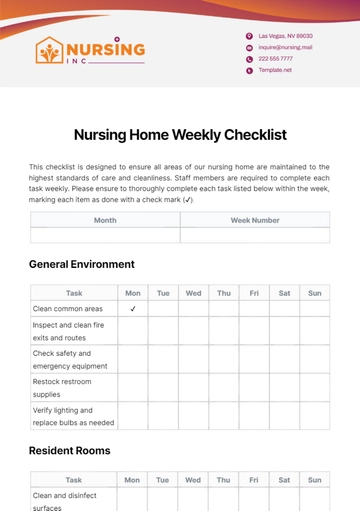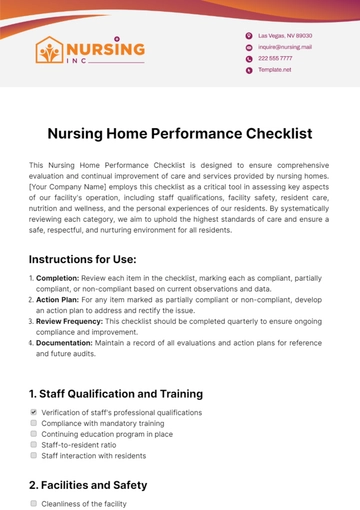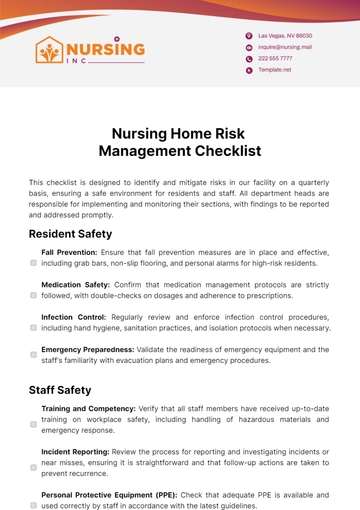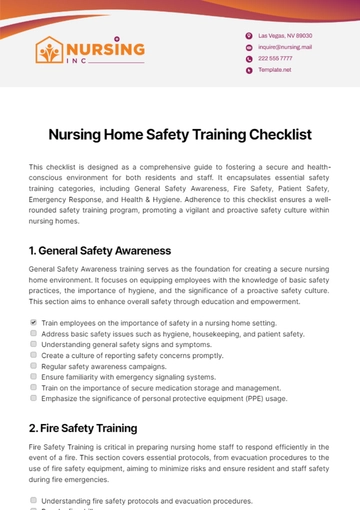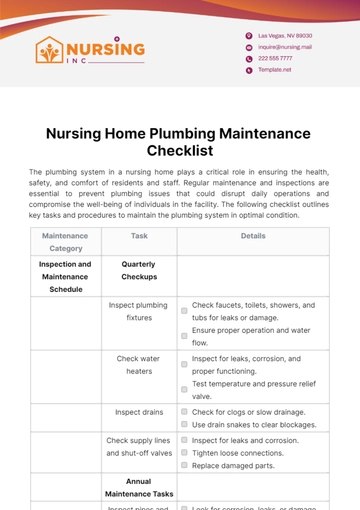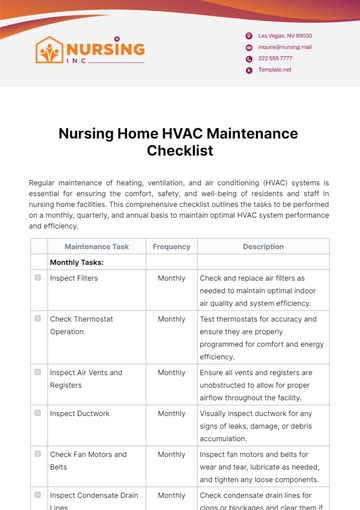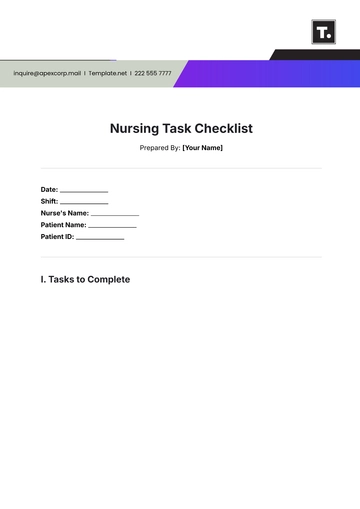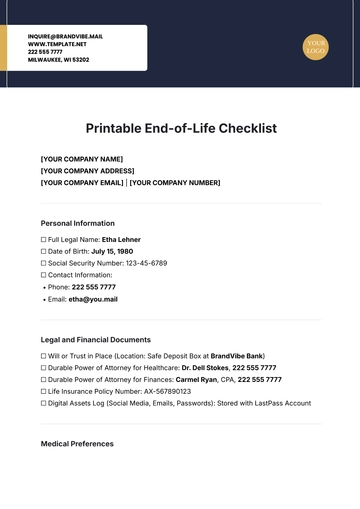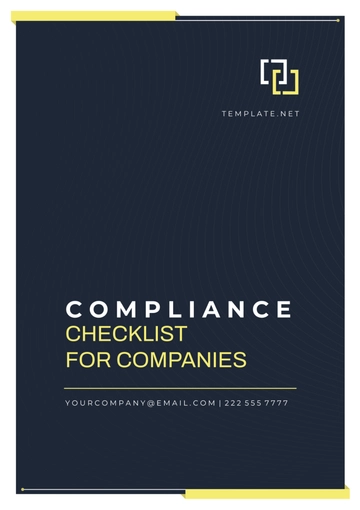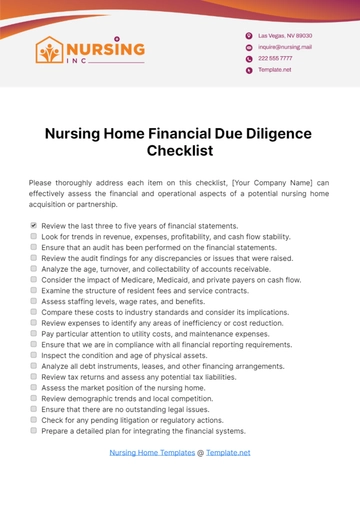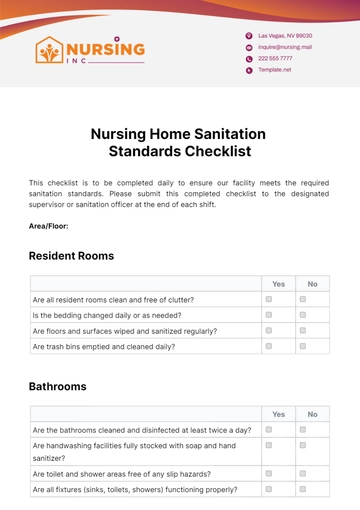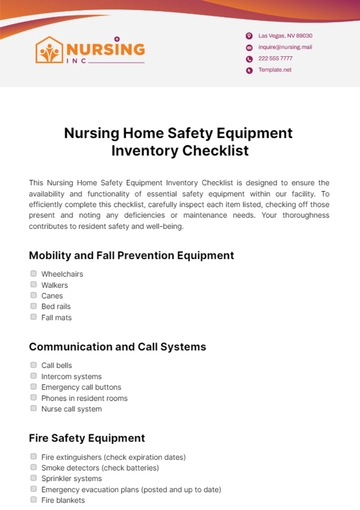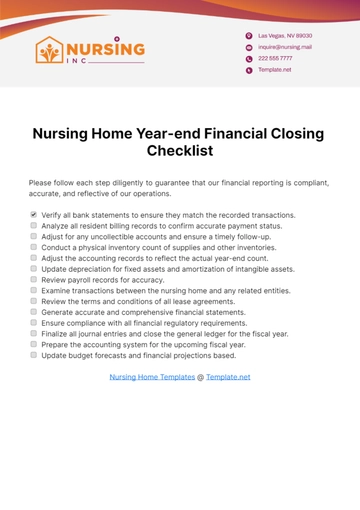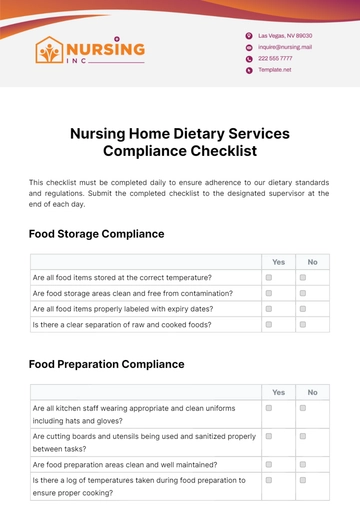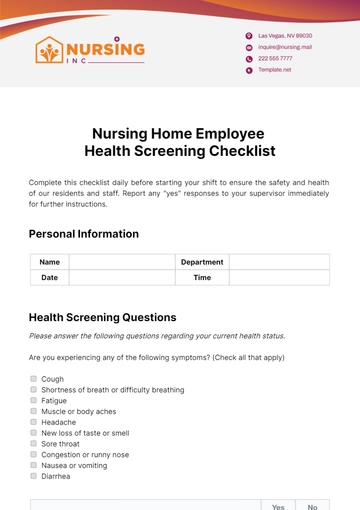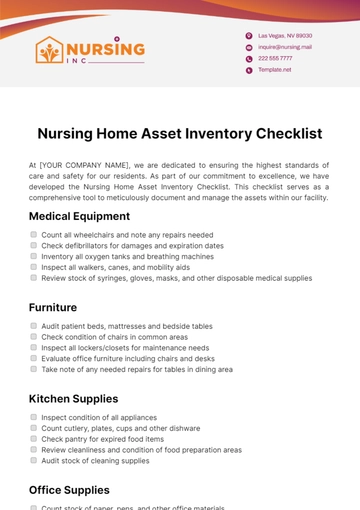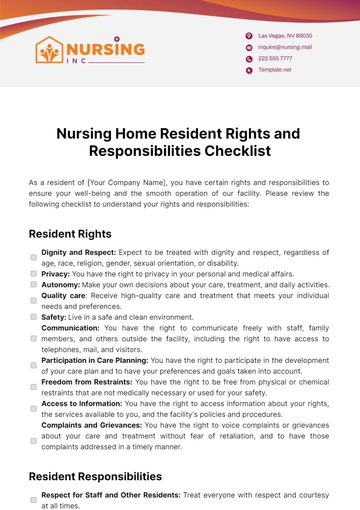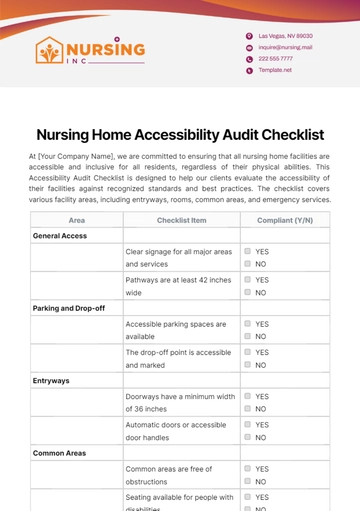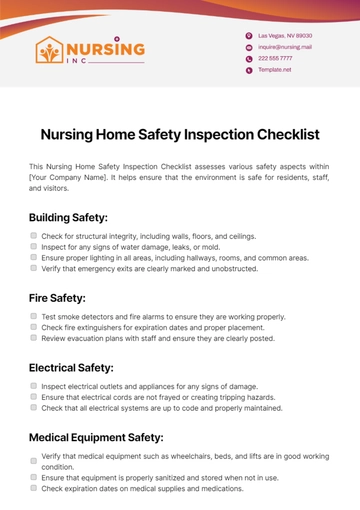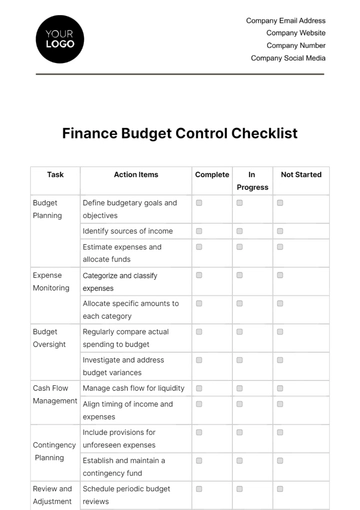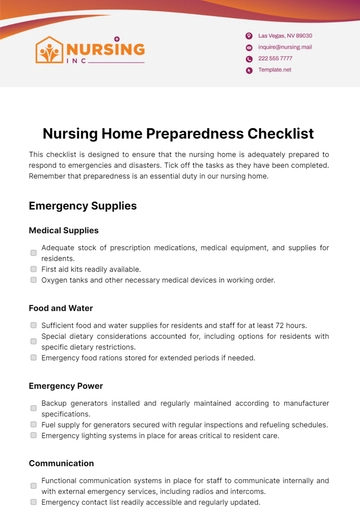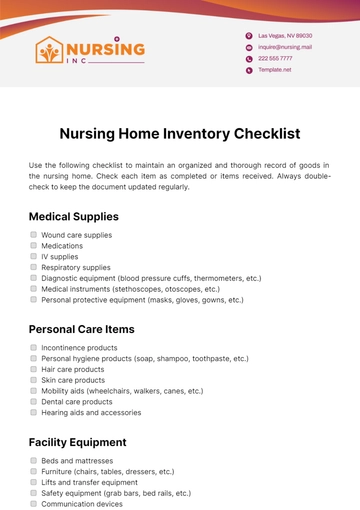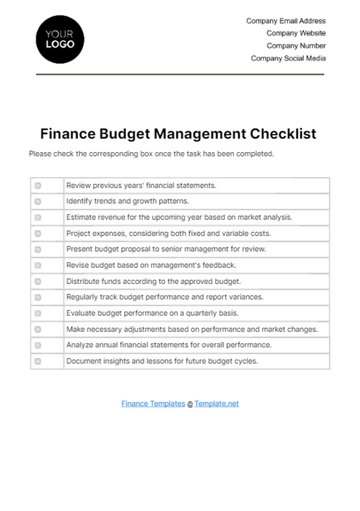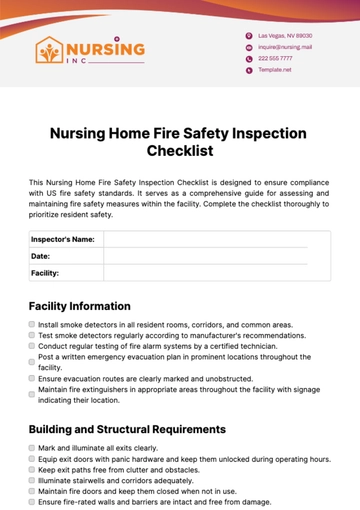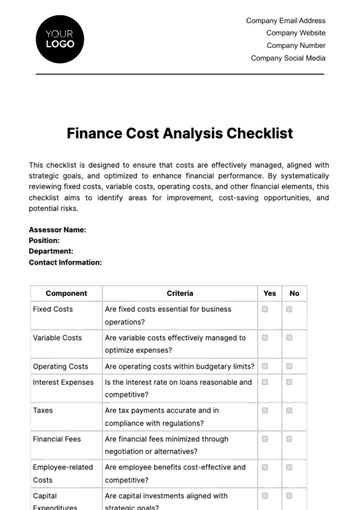Free Nursing Home Safety Training Checklist
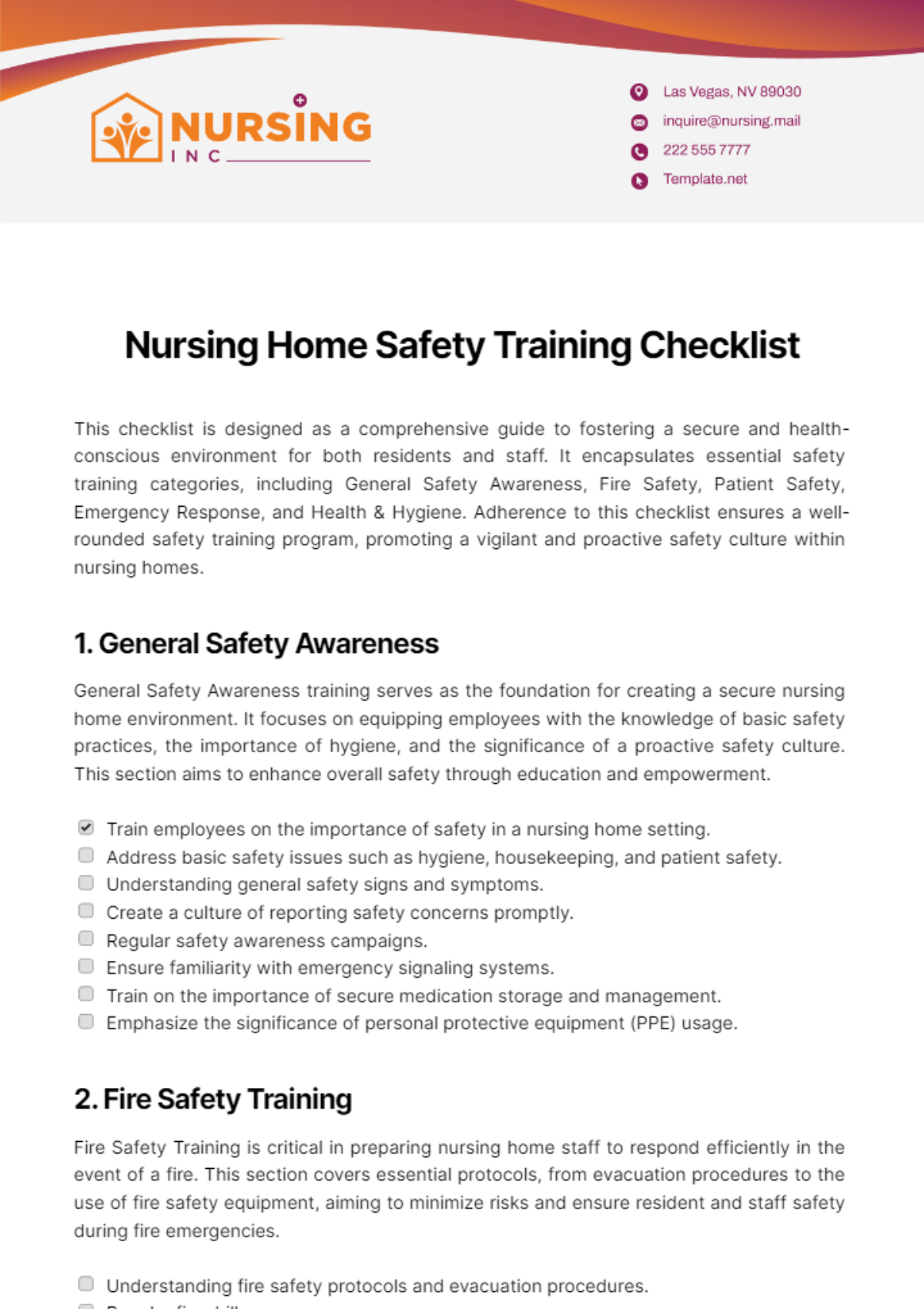
This checklist is designed as a comprehensive guide to fostering a secure and health-conscious environment for both residents and staff. It encapsulates essential safety training categories, including General Safety Awareness, Fire Safety, Patient Safety, Emergency Response, and Health & Hygiene. Adherence to this checklist ensures a well-rounded safety training program, promoting a vigilant and proactive safety culture within nursing homes.
1. General Safety Awareness
General Safety Awareness training serves as the foundation for creating a secure nursing home environment. It focuses on equipping employees with the knowledge of basic safety practices, the importance of hygiene, and the significance of a proactive safety culture. This section aims to enhance overall safety through education and empowerment.
Train employees on the importance of safety in a nursing home setting.
Address basic safety issues such as hygiene, housekeeping, and patient safety.
Understanding general safety signs and symptoms.
Create a culture of reporting safety concerns promptly.
Regular safety awareness campaigns.
Ensure familiarity with emergency signaling systems.
Train on the importance of secure medication storage and management.
Emphasize the significance of personal protective equipment (PPE) usage.
2. Fire Safety Training
Fire Safety Training is critical in preparing nursing home staff to respond efficiently in the event of a fire. This section covers essential protocols, from evacuation procedures to the use of fire safety equipment, aiming to minimize risks and ensure resident and staff safety during fire emergencies.
Understanding fire safety protocols and evacuation procedures.
Regular fire drills.
Proper usage of fire extinguishers.
Safe storage and handling of flammable materials.
Importance of maintaining fire safety equipment.
Training on identifying potential fire hazards in a nursing home setting.
Evacuation strategy planning, including for immobile residents.
Familiarization with fire detection and alarm systems.
3. Patient Safety Training
Patient Safety Training is dedicated to ensuring the well-being and security of residents through the proper handling, care, and management of potential risks. This section emphasizes the importance of fall prevention, correct equipment usage, and the management of patient behavior to foster a safe living environment.
Training on safe handling and moving of patients.
Prevention of falls and accidents.
Correct use of patient aids and equipment.
Managing aggressive behavior and agitation in patients.
Proper medication management to avoid errors.
Techniques for safely managing resident mobility and transfers.
Strategies for identifying and mitigating potential in-room hazards.
Guidance on effective communication for patient safety.
4. Emergency Response Training
Emergency Response Training equips staff with the necessary skills and knowledge to handle various medical and environmental emergencies. From first aid to the use of AEDs, this training ensures a timely and effective response to incidents, significantly improving outcomes for residents and staff alike.
Knowledge of First Aid and Cardiopulmonary resuscitation (CPR).
Handling medical emergencies like heart attacks, strokes, etc.
Training on use of Automatic External Defibrillators (AEDs).
Recognition and response to choking incidents.
Management of bleeding wounds.
Preparation for natural disasters specific to the area (e.g., hurricanes, earthquakes).
Response strategies for resident elopement.
Handling of biohazard exposures and incidents.
5. Health & Hygiene Training
Health & Hygiene Training is vital in preventing infections and maintaining a clean environment within the nursing home. This section focuses on practices ranging from hand hygiene to the safe disposal of medical waste, ensuring a high standard of cleanliness and health safety for residents and staff.
Effective hand washing and hygiene practices.
Infection prevention and control measures.
Safe handling and disposal of medical waste.
Food safety and nutrition awareness.
Bed sore prevention and wound care management.
Training on the latest protocols for managing infectious diseases.
Education on dietary restrictions and safe food handling for residents with specific health conditions.
Implementation of cleanliness and hygiene checks.
Prepared By: [Your Name]
- 100% Customizable, free editor
- Access 1 Million+ Templates, photo’s & graphics
- Download or share as a template
- Click and replace photos, graphics, text, backgrounds
- Resize, crop, AI write & more
- Access advanced editor
Harness the power of Template.net's Nursing Home Safety Training Checklist Template. A comprehensive, highly customizable template, it ensures no safety steps are overlooked in nursing homes. Editable in our Ai Editor Tool, this seamless document guarantees precise and efficient safety training. Experience unparalleled convenience with its editable and tailor-fit features. Choose this template for a sure path to safety protocol compliance. Make it your resource tool for quality care.
You may also like
- Cleaning Checklist
- Daily Checklist
- Travel Checklist
- Self Care Checklist
- Risk Assessment Checklist
- Onboarding Checklist
- Quality Checklist
- Compliance Checklist
- Audit Checklist
- Registry Checklist
- HR Checklist
- Restaurant Checklist
- Checklist Layout
- Creative Checklist
- Sales Checklist
- Construction Checklist
- Task Checklist
- Professional Checklist
- Hotel Checklist
- Employee Checklist
- Moving Checklist
- Marketing Checklist
- Accounting Checklist
- Camping Checklist
- Packing Checklist
- Real Estate Checklist
- Cleaning Checklist Service
- New Employee Checklist
- Food Checklist
- Home Inspection Checklist
- Advertising Checklist
- Event Checklist
- SEO Checklist
- Assessment Checklist
- Inspection Checklist
- Baby Registry Checklist
- Induction Checklist
- Employee Training Checklist
- Medical Checklist
- Safety Checklist
- Site Checklist
- Job Checklist
- Service Checklist
- Nanny Checklist
- Building Checklist
- Work Checklist
- Office Checklist
- Training Checklist
- Website Checklist
- IT and Software Checklist
- Performance Checklist
- Project Checklist
- Startup Checklist
- Education Checklist
- Home Checklist
- School Checklist
- Maintenance Checklist
- Planning Checklist
- Manager Checklist
- Wedding Checklist
- Vehicle Checklist
- Travel Agency Checklist
- Vehicle Inspection Checklist
- Interior Design Checklist
- Backpacking Checklist
- Business Checklist
- Legal Checklist
- Nursing Home Checklist
- Weekly Checklist
- Recruitment Checklist
- Salon Checklist
- Baby Checklist
- Equipment Checklist
- Trade Show Checklist
- Party Checklist
- Hospital Bag Checklist
- Evaluation Checklist
- Agency Checklist
- First Apartment Checklist
- Hiring Checklist
- Opening Checklist
- Small Business Checklist
- Rental Checklist
- College Dorm Checklist
- New Puppy Checklist
- University Checklist
- Building Maintenance Checklist
- Work From Home Checklist
- Student Checklist
- Application Checklist

